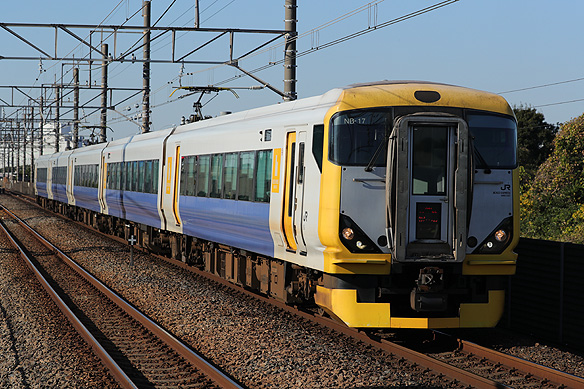Background and overview
In 2004, JR East developed E257-500 series intercity DC electric multiple
unit (EMU) trains in order to improve riding comfort and in order to displace
remaining 183 series EMU used on "Wakashio", "Sazanami",
and the other intercity services in Boso region, some of which were replaced
with 255 series EMU over the period from 1993 until 1994. 10 five-car sets
consisting of 3 motored vehicles and 2 trailer vehicles considering the
operation at the steep gradient of railways constructed under the ground
were delivered in 2004
Car body
The double-skinned aluminum alloy construction is incorporated into the vehicle design. This construction introduces dovetail groove to be fitted with equipments and interior parts as a substitute for joining them by welding in order to reduce welding points and improve body rigidness compared with existing method to build the body by welding skins, columns, and ribs together for cost reduction. Trailer end vehicles have a gangwayed cab section employing the head-on collision accident measure that its construction consists of crumple zone and safety cell. Their cab section has a built-in classification LED headboard on the gangway and clusters of head lights consisting of a shield beam and HID (high intensity discharge) lamps are fitted in right and left of the gangway door, and trapezoid shaped LED tail lights are also located in right and left of the gangway door. Anti-fall plates and anti-yaw dampers between vehicles are also introduced excepting the cab end. Class kuhaE257 end vehicles are equipped with two 900mm wide single-leaf sliding doors and the other vehicles are equipped with one. Wide fixed double-glazing UV cut windows aligned two seating bays are fitted. A LED destination screen is fitted beside each door. An air conditioner, AU302A, rated at 36,000kcal/h/unit is fitted under their floor Electric fans of air conditioner supply fresh air into the passenger room, instead of ventilators on the roof. All end vehicles are equipped with the automatic jumper coupler and class kuhaE257-500 vehicles are equipped with a pneumatic gangway connection device to ease rush-up operations. Their livery is bay beach white with sunny yellow accents and Pacific Ocean blue skirting.
Bogies
Powered bogies are DT64B, front trailer bogies of end vehicles are TR249D,
and rear trailer bogies of end vehicles are TR249C, featuring bolster-less
secondary air suspension, trailing arm link journal box supporting system,
the single link traction device, and the yaw dampers to ensure smooth ride
characteristics even at 130km/h. Their bogie frame employs bow-shape to
lower the bolster suspension. Twin Disc (TD) flexible joint employing deflecting
plates made of carbon-fiber reinforced plastic (CFRP) is applied for power
transmission device. The gear ratio is 5.65. Motored bogies employ single
tread brake device and trailer bogies employ both single disk brake device
and single tread brake device. TR249D also employs parking brake device.
Traction unit and ancillary equipments
Class mohaE257-500 vehicles are equipped with a 2-step variable frequency drive, SC78, employing Insulated Gate Bipolar Transistor (IGBT) and featuring fields-oriented control. Their traction system controls 8 AC asynchronous traction motors, MT72B, with a power output of 145kW of class mohaE257-500 and class mohaE256-500 powered intermediate vehicles on vehicle basis. On the other hand, class mohaE257-1500 vehicles are equipped with a 2-step variable frequency drive, SC79, which controls 4 traction motors of themselves. End vehicles are equipped with a motor driven rotary-screw air compressor, MH1322-C1400S, under their floor. Class mohaE256-500 and kuhaE256-500 vehicles are equipped with a full-time parallel inverter auxiliary power supply, SC80, with a power output of 210kVA. Class mohaE257-500 and mohaE257-1500 vehicles are equipped with a single-arm current pickup, PS37, on their roof, and a traction resistor unit under their floor. They employ the electric commanding brake with mixed regenerative-dynamic braking under low possibility of regeneration., featuring brake control of trailer priority. The end vehicles are equipped with the ATS-P, and ATS-SN signaling systems under their floor.
Accommodation
Their accommodation is 2+2 abreast adjustable reclining seating with 960mm seating pitch. Their seating is covered with blue fabric featuring accents, "b", from the initial of "Boso". A definite clearance exists between the ceiling and the partitions of a passenger saloons, conductor rooms, and toilets for air circulation to achieve uniform air-conditioning throughout. The outlets of air conditioning are located below the leading end of the overhead luggage rack and conditioned air flow horizontally. The passenger saloons employ indirect lighting featuring fluorescent bulb. Seats are equipped with the hand-grabs. A door between a vestibule and a passenger saloon is automatic, detecting by the fibre sensor. A LED display for providing passenger information is fitted above the door between a vestibule and a passenger saloon. Class kuhaE257-500, mohaE256-500, and mohaE257-1500 vehicles are equipped with a western style toilet employing the vacuum toilet system, a flashing urinal, and a washroom. A toilet of class mohaE257-1500 is universal access with a flip-up diaper-changing station. The other toilets have a flip-up high chair. Class mohaE257-1500 is also equipped with a catering room and a multipurpose room. As for the device of driving cab, the control desk of the driver's cab is equipped with a one handle master controller operated by the left hand.
Additional delivery
JR East additionally delivered 9 five-car sets to displace remining 183 series EMU over the period from July 2005 until October 2005.
Modification and scrap
Surplus 4 train sets were modified into E257-2500 series trainsets and redeployed on Tokaido line "Odoriko" intercity services in 2019. Remaining surplus 5 train sets were also modified into -5500 subseries.
Operations
They entered some part of "Wakashio" and "Sazanami" intercity services in October, 2004. Subsequently, they replaced remining 183 series used on "Shiosai" and "Ayame" intercity services completely in December 2005. However, surplus train sets caused by the reduction of the Chiba area intercity services, were deployed into "Home liner Chiba" and inter-running services to and Fuji-kyuko Line. Eventually, they are now used on Chiba area intercity services, "Wakashio", "Sazanami", "Ayame", and "Shiosai" after discontinuance of "Home Liner Chiba" services. |
|

